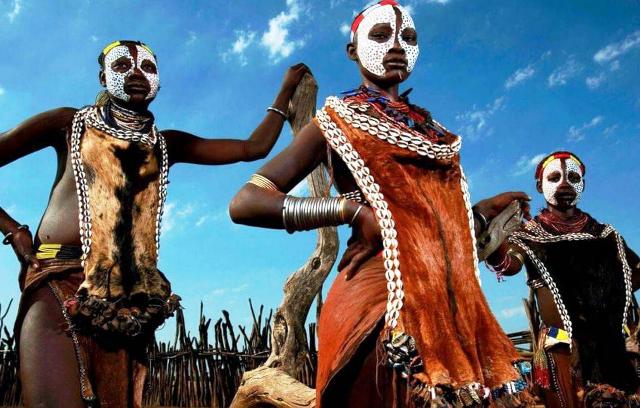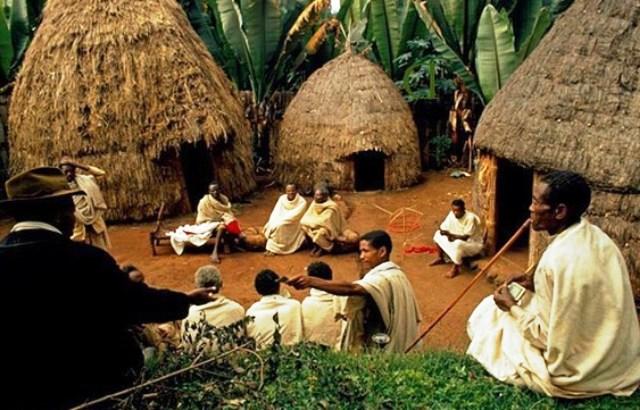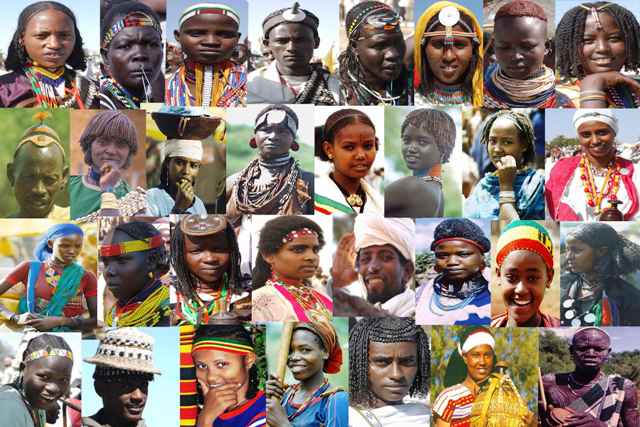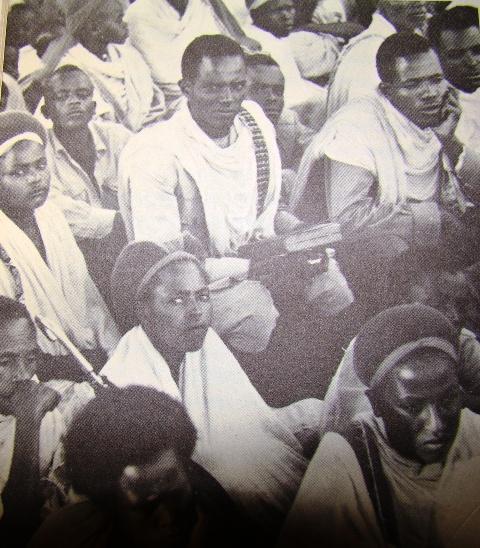
Wolaita and the Southern Peoples of Ethiopia
Wolaita People
Wolaita ( ወላይታ) sometimes interchangeable with Wolayta is the name given to the inhabitants of the northern Omo basin in the Great Rift Valley of central south Ethiopia.
The etymology of the word Wolaita is not clear. However, it is speculated that the word came from “Wolaheta”, meaning mixed, the mixed people or the leaves of a Gagnatic tree which symbolizes one with many branches.
Therefore, it is believed that the Wolaita are a mixture of various groups or tribes with diverse origins but mostly emanating from within the boundaries of current day Ethiopia.
The language of the Wolaita is referred to as Wolaitigna (ወላይትኛ) or Wolaitatuwa for the native speakers.

Historians classify these people as being part of the Omotic family, due to their close proximity to the Omo River.
Throughout Ethiopia there exist five different classifications of language families.
Wolaitans were the early inhabitants of the region and had developed a fairly advanced civilization, with their own kings and currency.
History of Wolaita
Historically and prior to its incorporation to Ethiopia, it is believed that the Wolaita and its people had administrative areas extending till the Rudolf River in the northern and southern Shewa or the northern part of Ethiopia’s current land mass.
The “Damot” administration refers to the system of governance employed by the southern peoples, before being incorporated into the Ethiopian empire.
The area under this administration is believed to have been south of the Blue Nile, in places such as: Wolega, South Gojam, Keffa, South Shewa (Enner Gurage), Kenbata, Arsi, Dawuro, Wolaita, Hadiya, Maraki, Mello, Gamo, Gofa, Maalle, Basketo, and Yem.

The chosen centralized king of this area was predominantly from Damot Eneriya and Buzamo, made up from the Kanbata, Ganz, Gafat, Kulu, Konta, Wolaita, Marako, Yem, Garo, Azernete-Berber, Enner Gurage, etc.
Every district also had its own kings based on their clan’s hierarchy and they were actively engaged in mining, mostly gold mining.
Religon of Wolaita
The southern peoples were also closely engaged with their northern counterparts.
King Amde Tsion is believed to have built churches throughout the region, and the Zagwe Dynasty also contributed by sending missionaries representing the Ethiopian Orthodox Church to the powerful Damot King Motolomi and his people, who at the time, aside from a few exceptions, were largely pagan.
Wars and Battles of Wolaita
The southerners also took part in a war between Atse Libne Dingel and the infamous Gragn Ahmed.
The Kenbata Queen Hamalmal is credited for averting the mass forceful conversion of Christians to Islam, by organizing around 400 Portuguese soldiers to help her defeat Gragn Ahmed in their region.
The Kenbata, the Dawuro, the Wolaita and the Hadiya were all participating in this war.
During this time, Queen Hamalmal was also able to bring together the southerners to ward off Oromo expansionists, with battles taking place in Arusi.
Kawo Tona Gaga, the last king of the Wolaita kingdom was believed to be one of the greatest warriors and most powerful king of Wolaita.

His army defeated King Menelik's forces six times before losing to the combined forces of Menelik and Abba Jiffar in 1896. At the final battle, he was wounded and captured.
Although, later released and allowed to continue being a figurehead leader, the Wolaita would see no new kings.
Ethiopian emperors would appoint centralized governors to rule over the Wolaita people and their territory.
Clans of Wolaita
The historical legacy of the Wolaita and their dynasty is still evident and passed down orally, among the over 200 clans, which are divided into two main sub-clans.
The large majority of the clansmen can be found in Wolaita and its neighboring regions.

Some of the major clans include the Tigre, Wolaita Malla, Zirgo Malla, Hiziya, Weshesha, Homine, Amara, Homi Girra, etc.
An interesting aspect of some of the Wolaita clans is that they can trace their ancestry to major Ethiopian ethnicities, such as the Amhara, Tigre and Oromo.
Leading the region for over a thousand years, the Tigre clans of Wolaita are believed to be among the most dominant clans, second only to the Wolaita Mallas.
The most notable kings of these clans include the King Damote and the last king of Wolaita, King Tona who both hailed from the Tigre dynasty, while King Motolomi was the most notable from the Wolaita Malla dynasty.
Incorporated into the Ethiopian Empire
Beginning with the reign of Emperor Menelik II and ending with the overthrow of Emperor Haile Selassie I in 1974, the southern peoples of Ethiopia were ruled for over 80 years with what is termed as “settler rule” or in Amharic “neftegna sireat”.
The new rulers were determined to get rid of most of the indigenous political structures by removing the highest levels of traditional authority.
Yet in still, an important factor was left in place, and this was the so called “balabat” or chieftain, this helped alleviate some of the deterioration of cultural preservation and maintain its continuity.
Nevertheless, the relationship between the southerners and their northern counterparts was that of master and subject, landlord and tenant, tax collector and taxpayer.

This relationship was reinforced by force with the use of riflemen also referred to as “neftegna”, who would maintain control over the people and areas.
Lack of Awareness and Infighting
With the loss of their unity and identity, fights are common to this day between the southern peoples’ tribes. For example there has been infighting between them for small cases such as ownership of grazing land, marriage related squabbles, farm land disputes, cattle rustling, etc.
Some recorded battles include the fighting between the Docko Dalo and the Doko Masho, the Boreda and the Wolaita, the Kanbata and the Marqo, the Sidama and the Oromo or Burji, the Benna and the Tsami, the Tsami and the Konso, the Maalle and the Bena, the Mursi and the Geleb, etc.

Knowledge about the relative similarities between the southern peoples is also very rare, for example, Ethiopians consider the weaving done by southerners to be a very unique and highly valued product.
But unfortunately, only the name Dorze lingers, as most people believe the weaved local handmade cloth (Dungaza) to originate from the Dorze tribe, but the Gamo, the Ocholo, the Sullaa, the Docko, the Azo, the Barana, and several other tribes are also historically and equally tied to the weaving tradition as the Dorze.
There are several damaging messages being passed around that cause the many tribes to increase their hostilities among one another. The following are just some of the thinking that has led to much of the infighting:
1. The tribes of the southern people are close to extinction.
2. The Wolaitas are closer to the Sidamas, as opposed to the Gamo Gofas, Dawuros, Kenbatas, etc.
3. The Dorze are different from the Gamo Gofa, even though they both share cultural and traditional similarities.
4. The Dorze are the only tribe of people that have accepted the Christian Orthodox religion, making them different from the other Gamo people.
5. The Gamo and Gofa are different people.
6. The Qucha are not similar to the Gamo, Gafa, Boreda Daramalor, Dawuro, Malo, and Wolaita people.
7. The Basketo, Malle, Mello, Qucha do not share any similarities with the Gofa.
8. The Konso are not similar to the Gawada, Gidole, Darashe, Tsami, Arbore, and Birale.
9. The Hammar and Banna are not one people.
10. The Sidama are different from the Gedeo, Kachama, and Oromos in the region.
11. The Kenbata are different from the Hadiya, Maraqo, and other members of the southern peoples, due to their links to the Solomonic dynasty.
12. The Mursis are not similar to the Geleb, Surma, and Dizi people.
Classification of the Southern Peoples of Ethiopia
GROUP ONE
PEOPLE-NAME-POPULATION-RELIGION-ETHNIC CODE
Aari - 1.9% 358000 Christianity CMT33d
Basketo - 0.52% 97000 Christianity CMT33d
Bench - 2.34% 435000 Christianity CMT33d
Dime - < 0.01% 1100 Christianity CMT33d
Dizi - 0.23 43,000 Christianity CMT33d
Anffilo 4300 Islam CMT33d
Oyda - 0.25% 56000 Christianity CMT33d
Kafficho - 5.44% 1,068,000 Christianity CMT33d
Sheko - 0.24% 46000 Christianity CMT33d
Shakacho, Mocha- 0.44% 96000 Christianity CMT33d
Chara - 0.08% 16,000 Ethnic religion CMT33d
Yem/Yemse - 0.5% 198000 Christianity CMT33d
Begi-mao 26000 Islam CMT33d
Gayil 63,000 Christianity CMT33d
Nao 12000 Christianity CMT33d
Suri/Surma - 0.176,875 Ethnic religion CMT33z
Seze 5400 Ethnic religion CMT33d
GROUP TWO
PEOPLE-NAME-POPULATION-RELIGION-ETHNIC CODE
Gurage - 7.54% 1,867,377 Christianity CMT33d
Silte - 5.37% 1,288,000 Christianity, Moslem CMT33d
Alaba - 1.35% 287000 Islam CMT33d
Kebena 65000 Islam CMT33d
Kambaata - 3.82% 775,000 Christianity CMT33d
Hadiya - 7.98% 1,568,000 Christianity CMT33d
Libido,Mareqo 0.38% 79000 Islam CMT33d
Sidama - 19.38% 3,646,000 Christianity CMT33d
Kachama, Haruro 3200 Ethnic religion CMT33d
Baiso 6800 Christianity CMT33Z
GROUP THREE
PEOPLE-NAME-POPULATION-RELIGION-ETHNIC CODE
Dorze 47,000 Christianity CMT33z
Gamo - 7% 1,364,000 Christianity CMT33d
Goffa - 2.41% 447,000 Christianity CMT33d
Male - 0.59% 121,000 Ethnic religion CMT33d
Mello 36000 Christianity CMT33d
Wolaita - 10.59% 2,070,000 Christianity CMT33d
Zayse,Zergula - 0.1% 22000 Ethnic religion CMT33d
Dawro - 3.28% 664,000 Christianity CMT33d
Karo - 0.01% 1,800 Ethnic religion CMT33d
Burji - 0.38% 114,000 Christianity CMT33d
Bununji 118,000 Ethnic religion CMT33d
GROUP FOUR
PEOPLE-NAME-POPULATION-RELIGION-ETHNIC CODE
Arbore - 0.04% 9000 Ethnic Religion CMT33Z
Birale 100 Ethnic religion CMT33Z
Konso - 1.47% 311000 Christianity CMT33d
Gawwada - 0.43% 85,000 Ethnic religion CMT33d
Gidole 51,000 Christianity CMT33d
Gedeo - 4.9% 1,205,000 Christianity CMT33d
Tsamai - 0.13% 25000 Ethnic religion CMT33d
GROUP FIVE
PEOPLE-NAME-POPULATION-RELIGION-ETHNIC CODE
Busa Dobasa 24,000 Christianity CMT33d
Bodi - 0.04% 56,585 Ethnic religion CMT33Z
Daasanach - 0.32% 48,067 Ethnic religion CMT33Z
Ganza 3400 Ethnic religion CMT33d
Hamar, Bena 0.31% 91,000 Ethnic religion CMT33d
Iraqw 641,000 Ethnic religion CMT33C
Mursi - 0.05% 7,500 Ethnic religion CMT33c
Nyangatom - 0.12% 30,000 Ethnic religion CMT33c
Shinasha Borna 77,000 Christianity CMT33d
Koorete - 1.02% 194000 Christianity CMT33d
*Note: “Please understand our grouping in these categories was not done with a high degree of scientific precision. We did not use DNA analysis. Much of this work was done based on languages-spoken, that is, the language trees that show how languages relate to each other.”
Joshua Project
See also:
Ethiopian Language: Useful Phrases in Wolaytegna - Wolaytigna - Wolaita Language

